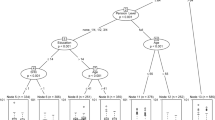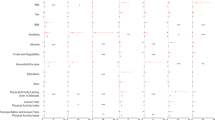Abstract
Objectives:
To study disability-management self-efficacy (DMSE) and its correlates in a large sample of Dutch people with long-standing spinal cord injury (SCI). DMSE is the confidence that people with SCI may have in their ability to manage the consequences of their condition with respect to the various domains in their life. Research questions were: (1) What is the level of DMSE in Dutch people with long-standing SCI?; (2) Is DMSE associated with demographic and lesion characteristics?; and (3) Is DMSE associated with participation and life satisfaction if these associations are adjusted for demographic and lesion characteristics and mood?
Methods:
Eligible people were identified from all eight rehabilitation centers with a specialty in SCI rehabilitation in the Netherlands (N=261). Data were collected using a self-report questionnaire. DMSE was measured using the University of Washington Self-Efficacy Scale–Short Form (UW-SES-6). Correlation and linear regression analyses were used.
Results:
Levels of UW-SES-6 scores were largely independent of demographic and lesion characteristics. UW-SES-6 scores were bivariately moderately to strongly associated with mood (0.47), participation (0.39–0.51) and life satisfaction (0.46). In the regression analyses, UW-SES-6 scores still explained a significant amount of variance of participation (standardized β 0.31–0.33) and life satisfaction (standardized β 0.21) when controlling for demographic and lesion characteristics and mood, and explained an additional 3.2–8.1% of the variance of participation and life satisfaction.
Conclusion:
DMSE is a psychological resource associated with higher levels of participation and life satisfaction after SCI. The UW-SES-6 is a brief and easy to use measure of this psychological resource.
Similar content being viewed by others
Log in or create a free account to read this content
Gain free access to this article, as well as selected content from this journal and more on nature.com
or
References
Bickenbach J, Officer A, Shakespeare T, Von Groote P (eds). International Perspectives on Spinal Cord Injury. World Health Organization: Geneva. 2013.
Noreau L, Fougeyrollas P, Post MW, Asano M . Participation after spinal cord injury: the evolution of conceptualization and measurement. J Neurol Phys Ther 2005; 29: 147–156.
Post MW, van Leeuwen CM . Psychological issues in spinal cord injury: a review. Spinal Cord 2012; 50: 382–389.
van Leeuwen CMC, Kraaijeveld S, Lindeman E, Post MW . Associations between psychological factors and quality of life ratings in persons with spinal cord injury: a systematic review. Spinal Cord 2012; 50: 174–187.
Bandura A . Self-efficacy: toward a unifying theory of behavioral change. Psychol Rev 1977; 84: 191–215.
Peter C, Muller R, Cieza A, Geyh S . Psychological resources in spinal cord injury: a systematic literature review. Spinal Cord 2012; 5: 188–201.
Middleton JW, Tate RL, Geraghty TJ . Self-efficacy and spinal cord injury: psychometric properties of a new scale. Rehabil Psychol 2003; 48: 281–288.
Amtmann D, Bamer AM, Cook KF, Askew RL, Noonan VK, Brockway JA . University of Washington Self-Efficacy Scale: a new self-efficacy scale for people with disabilities. Arch Phys Med Rehabil 2012; 93: 1757–1765.
Fliess-Douer O, van der Woude LH, Vanlandewijck YC . Development of a new scale for perceived self-efficacy in manual wheeled mobility: a pilot study. J Rehabil Med 2011; 43: 602–608.
King RB, Porter SL, Vertiz KB . Preventive skin care beliefs of people with spinal cord injury. Rehabil Nurs 2008; 33: 154–162.
Miller SM . The measurement of self-efficacy in persons with spinal cord injury: psychometric validation of the moorong self-efficacy scale. Disabil Rehabil 2009; 31: 988–993.
Brooks J, Smedema SM, Tu W-M, Agle D, Catalano D, Chan F . Psychometric validation of the Moorong self-efficacy scale in people with spinal cord injury: a brief report. Rehabil Counsel Bull 2014; 58: 54–57.
Munce SE, Straus SE, Fehlings MG, Voth J, Nugaeva N, Jang E et al. Impact of psychological characteristics in self-management in individuals with traumatic spinal cord injury. Spinal Cord 2016; 54: 29–33.
Craig A, Nicholson Perry K, Guest R, Tran Y, Middleton J . Adjustment following chronic spinal cord injury: Determining factors that contribute to social participation. Br J Health Psychol 2015; 20: 807–823.
Adriaansen JJE, van Asbeck FWA, Lindeman E, van der Woude LHV, de Groot S, Post MWM . Secondary health conditions in persons with a spinal cord injury for at least 10 years: design of a comprehensive long-term cross-sectional study. Disabil Rehabil 2013; 35: 1104–1110.
Ware JE, Sherbourne CD . The MOS 36-itme short-form health survey (SF-36). I. Conceptual framework and item selection. Med Care 1992; 30: 473–483.
Van Leeuwen CMC, van der Woude LHV, Post MWM . Validity of the mental health subscale of the SF-36 in persons with spinal cord injury. Spinal Cord 2012; 50: 707–710.
The WHOQOL Group. The World Health Organization Quality of Life Assessment (WHOQOL): development and general psychometric properties. Soc Sci Med 1998; 46: 1569–1585.
Geyh S, Fellinghauer BAG, Kirchberger I, Post MWM . Cross-cultural validity of four quality of life scales in persons with spinal cord injury. Health Qual Life Outcomes 2010; 8: 94.
van der Zee CH, Kap A, Rambaran Mishre R, Schouten EJ, Post MW . Responsiveness of four participation measures to changes during and after outpatient rehabilitation. J Rehabil Med 2011; 43: 1003–1009.
Post MW, van der Zee CH, Hennink J, Schafrat CG, Visser-Meily JM, van Berlekom SB . Validity of the Utrecht scale for evaluation of rehabilitation-participation. Disabil Rehabil 2012; 34: 478–485.
Van der Zee CH, Post MWM, Brinkhof MW, Wagenaar RC . Comparison of the Utrecht Scale for Evaluation of Rehabilitation-Participation with the ICF Measure of Participation and Activities Screener and the WHO Disability Assessment Schedule II in persons with spinal cord injury. Arch Phys Med Rehabil 2014; 95: 87–93.
Kirshblum SC, Burns SP, Biering-Sorensen F, Donovan W, Graves DE, Jha A et al. International standards for neurological classification of spinal cord injury (revised 2011). J Spinal Cord Med 2011; 34: 535–546.
Cohen J . Statistical Power Analysis for the Behavioural Sciences 2nd edn. Lawrence Erlbaum: Hillsdale. 1988.
Juvalta S, Post MW, Charlifue S, Noreau L, Whiteneck G, Dumont FS et al. Development and cognitive testing of the Nottwil Environmental Factors Inventory in Canada, Switzerland, and the USA. J Rehabil Med 2015; 47: 618–625.
Geyh S, Nick E, Stirnimann D, Ehrat S, Michel F, Peter C et al. Self-efficacy and self-esteem as predictors of participation in spinal cord injury – an ICF-based study. Spinal Cord 2012; 50: 699–706.
van Leeuwen CM, Post MW, Westers P, van der Woude LH, de Groot S, Sluis T et al. Relationships between activities, participation, personal factors, mental health, and life satisfaction in persons with spinal cord injury. Arch Phys Med Rehabil 2012; 93: 82–89.
Marks R, Allegrante JP, Lorig K . A review and synthesis of research evidence for self-efficacy-enhancing interventions for reducing chronic disability: implications for health education practice (part II). Health Promot Pract 2005; 6: 148–156.
Acknowledgements
ALLRISC is sponsored by ‘Fonds NutsOHRA’ under the responsibility of the Netherlands Organisation for Health Research and Development (www.ZonMW.nl), Project number 89000006.
Author information
Authors and Affiliations
Consortia
Corresponding author
Ethics declarations
Competing interests
The authors declare no conflict of interest.
Additional information
ALLRISC group LHV van der Woude9, TWJ Janssen10, H Bussmann11, C Smit12, M Sloots12, D van Kuppevelt13, H Rijken13, W Faber14, L Valent14, G Snoek15, M Schuitemaker15, F Woldring16, H Bongers17, S Slangen17, M Wynants17, T Sluis18, R Broeksteeg18, P Luthart19 9University of Groningen, University Medical Center Groningen, Center for Human Movement Sciences, Center for Rehabilitation, Department of Rehabilitation Medicine, Groningen, The Netherlands; 10MOVE Research Institute Amsterdam, Faculty of Human Movement Sciences, VU University Amsterdam, The Netherlands; 11Department of Rehabilitation Medicine and Physical Therapy, Erasmus MC University Medical Centre, Rotterdam, The Netherlands; 12Amsterdam Rehabilitation Research Centre, Reade, Amsterdam, The Netherlands; 13Sint Maartenskliniek, Nijmegen, The Netherlands; 14Rehabilitation Center Heliomare, Wijk aan Zee, The Netherlands; 15Roessingh Rehabilitation Center, Enschede, The Netherlands; 16University Medical Center Groningen, Center for Rehabilitation, Department of Rehabilitation Medicine, Groningen, The Netherlands; 17Adelante Zorggroep, Hoensbroek, The Netherlands; 18Rijndam Rehabilitation Center, Rotterdam, The Netherlands; 19Rehabilitation Center De Hoogstraat, Utrecht, The Netherlands.
Rights and permissions
About this article
Cite this article
Cijsouw, A., Adriaansen, J., Tepper, M. et al. Associations between disability-management self-efficacy, participation and life satisfaction in people with long-standing spinal cord injury. Spinal Cord 55, 47–51 (2017). https://doi.org/10.1038/sc.2016.80
Received:
Revised:
Accepted:
Published:
Issue date:
DOI: https://doi.org/10.1038/sc.2016.80
This article is cited by
-
The Swedish version of the Moorong Self-Efficacy Scale (s-MSES) – translation process and psychometric properties in a community setting
Spinal Cord (2024)
-
Psychological screening of significant others during spinal cord injury rehabilitation
Spinal Cord (2024)
-
Learning self-care skills after spinal cord injury: a qualitative study
BMC Psychology (2021)
-
Enhancing our conceptual understanding of state and trait self-efficacy by correlational analysis of four self-efficacy scales in people with spinal cord injury
BMC Psychology (2020)
-
Active Rehabilitation for persons with spinal cord injury in Botswana – effects of a community peer-based programme
Spinal Cord (2019)



